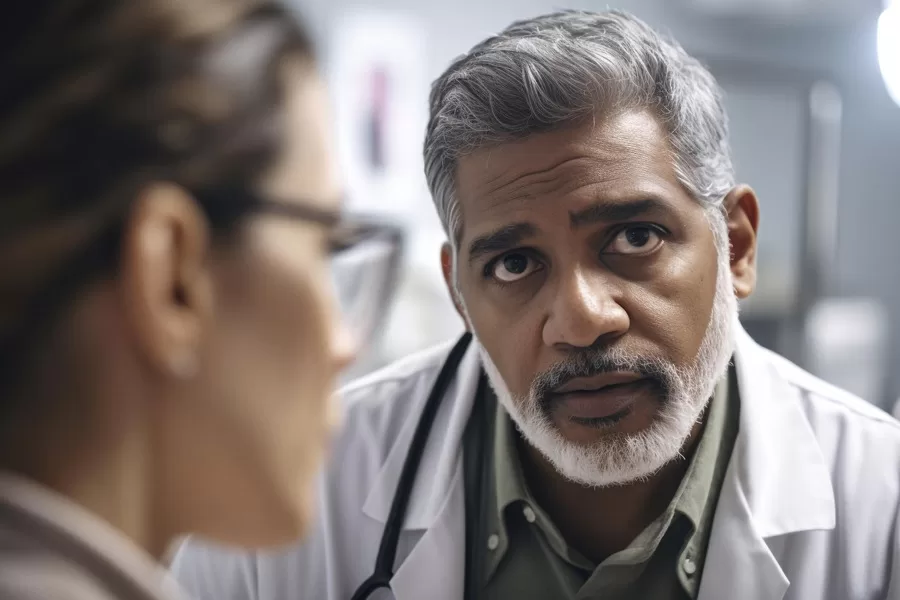
As a rule, men over 45 years of age may experience an enlarged prostate, likewise known as benign prostatic hyperplasia. Although prostate enlargement is not considered a cancerous condition, it is still recommended to diagnose it timely and start an effective treatment. This article covers major symptoms and diagnosis means of enlarged prostate. Moreover, helpful prevention measures will be regarded so you avoid this unpleasant condition.
What is Benign Prostatic Hyperplasia
Before switching to ways of determination of prostate enlargement, there is a need to sort out what it means. Benign prostatic hyperplasia or prostate enlargement is a condition in which the prostate gland becomes enlarged.
This is a non-cancerous enlargement of the prostate that usually affects older men. Benign prostatic hyperplasia isn’t regarded as a serious condition, however, it may cause discomfort and affect the quality of a man’s life.
Symptoms of an Enlarged Prostate
Usually, certain symptoms may indicate a man has an enlarged prostate. They are divided into urinary and sexual symptoms. If you experience any signs of benign prostatic hyperplasia, hasten to see your healthcare provider as soon as possible to prevent consequences from this condition.
Urinary
Prostate enlargement may cause definite urinary symptoms due to its pressure on the urethra, which represents a tube that carries urine out of the body. Some of the most usual urinary symptoms of benign prostatic hyperplasia are frequent urination, nocturia, difficulty starting urination, urgency to urinate, incomplete bladder emptying, etc.
Sexual
Aside from urinary symptoms, there are likewise sexual signs that may indicate benign prostatic hyperplasia. Although sexual symptoms occur rarely, they still may be caused by an enlarged prostate. Sexual symptoms of benign prostatic hyperplasia include erectile dysfunction, painful ejaculation, decreased libido or sex drive, etc.
Complications
As known, benign prostatic hyperplasia isn’t a cancerous condition. But if you leave prostate enlargement untreated, this may result in unpleasant consequences. For instance, some of the widespread complications of an enlarged prostate are urinary tract infections, bladder stones, kidney damage, sexual issues, and more.
Diagnosis
Benign prostatic hyperplasia symptoms are one of the methods of determination of this condition. If you experience prostate enlargement signs and want to additionally check you don’t have this condition, you may see your doctor and diagnose an enlarged prostate in other ways.
Digital Rectal Exam
A digital rectal exam is one way to diagnose benign prostatic hyperplasia. During this exam, the healthcare provider asks the patient to bend over a table or lie on his side and hold his knees close to his chest.
Then, the healthcare provider slides a lubricated, gloved finger into the rectum to verify the prostate gland for any abnormalities, for instance, enlargement, lumps, or nodules. Although the exam usually takes several minutes, a patient may still feel slight and brief discomfort during it.
Symptoms and Medical History
Another way of diagnosing prostate enlargement is to evaluate the medical history of a patient. Once you are at an appointment with your healthcare provider, you may be asked to report symptoms you are experiencing, involving detailed information on when they started and how severe they are. Your doctor may likewise ask you about any medical diseases you have, drugs you take, and a family history of prostate issues.
Laboratory tests
Laboratory tests may be likewise useful in diagnosing benign prostatic hyperplasia and excluding other conditions that can cause similar symptoms. Some of the most widespread laboratory tests employed to diagnose prostate enlargement are a prostate-specific antigen blood test, urinalysis, cystoscopy, biopsy, urodynamic tests, etc.
Ultrasound
Ultrasound is one of the diagnostic tests utilized to determine benign prostatic hyperplasia. As a rule, two types of ultrasound tests can assist in diagnosing prostate enlargement. They are transrectal ultrasound and abdominal ultrasound. Ultrasound is regarded as a secure and non-invasive test that can grant your healthcare provider useful information about the size and condition of the prostate gland.
MRI
Last but not least, the method of diagnosis of an enlarged prostate is magnetic resonance imaging. MRI employs a strong magnetic field and radio waves to obtain detailed images of the prostate gland and surrounding tissues.
This test is non-invasive and does not involve radiation. Aside from showing the size and shape of the prostate gland, an MRI test may likewise point to any abnormalities, for instance, nodules or tumors.
Prevention of BPH
Although there are no guaranteed means to prevent benign prostatic hyperplasia, there are definite lifestyle habits and medical treatments that may assist in decreasing the risk of developing prostate enlargement and alleviating its symptoms. Before you decide to start making any changes in your daily life, don’t forget to consult your healthcare provider.
Balanced diet
As known, an unhealthy diet may lead to certain serious health issues. Some of them are obesity, heart disease, tooth decay, high blood pressure, etc. Obesity, in turn, is connected with an increased risk of developing prostate enlargement. Luckily, adhering to a healthy diet may assist in reducing this risk.
For instance, you may add fruits, vegetables, and whole grains to your ration and replace unhealthy foods (burgers, pizzas, chocolate, sweets, cakes, biscuits, processed meat, chips, etc.). What’s more, certain foods, in particular, tomatoes, soy, and green tea may likewise have a protective effect.
Regular fitness
Staying physically active is also useful for your prostate and may assist in decreasing the risk of developing an enlarged prostate. You may be involved in any physical activity you like. It can be brisk walking, jogging, swimming, exercising at home, cycling, doing fitness, etc. Exercise may likewise assist in managing symptoms of an enlarged prostate by improving urinary flow and reducing inflammation.
Limiting alcohol and tobacco
There is no doubt that smoking and alcohol abuse is harmful to the overall health of men. What’s more, consuming too much alcohol may irritate the bladder and worsen urinary symptoms. If you limit alcoholic beverages drinking, you will have the possibility to manage these symptoms.
Also, according to some evidence, tobacco use may be connected with an increased risk of developing benign prostatic hyperplasia. That’s why it is recommended to limit tobacco use to prevent an enlarged prostate condition.
Summary
Nowadays, some men may face a condition known as enlarged prostate. The above-mentioned symptoms will be helpful for you in determining benign prostatic hyperplasia. Additionally, your healthcare provider may diagnose prostate enlargement by conducting certain tests and checks.
Even if you start to experience certain symptoms and signs of prostate enlargement, there is no need to worry. This condition may be treated if you see your healthcare provider as early as possible. What’s more, sticking to a balanced diet, exercising regularly, and avoiding smoking and alcohol may be useful prevention measures for an enlarged prostate.
FAQ
There are certain symptoms that you may experience that may indicate an enlarged prostate. They are difficulty starting urination, frequent urination, urgency to urinate, erectile dysfunction, painful ejaculation, and decreased sex drive.
An enlarged prostate is usually diagnosed by a healthcare provider through a digital rectal exam, laboratory tests, ultrasound, MRI, and a patient’s medical history.
The most common way to check for benign prostatic hyperplasia, likewise known as prostate enlargement is through a physical exam carried out by a healthcare provider.
As a rule, a urine test is not employed directly to detect an enlarged prostate. Nevertheless, it may grant your healthcare provider information about prostate health and assist in identifying other conditions that may influence the prostate gland.







